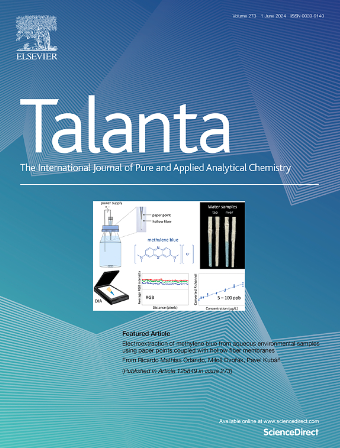Quantitative quadrupolar NMR (qQNMR) determination of taurine in undiluted human urine samples using 1D and 2D 33S NMR
IF 5.6
1区 化学
Q1 CHEMISTRY, ANALYTICAL
引用次数: 0
Abstract
A quantitative quadrupolar nuclear magnetic resonance (qQNMR) method based on sulfur-33 (33S) NMR has been developed for the direct, dilution-free determination of taurine in human urine, addressing matrix challenges in biofluid analysis. The 1D33S approach exhibited linearity (14–70 mg mL−1; R2 = 0.9993), LOD = 6.78 ± 0.66 mg mL−1, LOQ = 10.84 ± 0.69 mg mL−1, precision <1.1 % CV, and recoveries of 96.95–101.58 % with negligible matrix effect (−3.15 %). External calibration using ammonium sulfate yielded similar results. Critically, 2D 1H–33S gHMBC experiments reduced LOD/LOQ to 1.2/4.0 mg mL−1 by leveraging 1H sensitivity. The method enables rapid (<12 min), robust analysis without sample pretreatment, offering a practical alternative to chromatographic techniques for high-concentration urinary taurine quantification.
定量四极核磁共振(qQNMR)用1D和2D 33S核磁共振测定未稀释的人尿液样品中的牛磺酸
一种基于硫-33 (33S)核磁共振的定量四极核磁共振(qQNMR)方法已被开发出来,用于直接、无稀释地测定人类尿液中的牛磺酸,解决了生物流体分析中的基质挑战。1D33S方法呈线性(14-70 mg mL−1;R2 = 0.9993), LOD = 6.78±0.66 mg mL−1,LOQ = 10.84±0.69 mg mL−1,精密度& 1.1% CV,加样回收率为96.95 ~ 101.58%,基质效应可忽略(- 3.15%)。使用硫酸铵进行外部校准得到了类似的结果。关键是,2D 1H - 33s gHMBC实验利用1H灵敏度将LOD/LOQ降低到1.2/4.0 mg mL−1。该方法无需样品预处理即可实现快速(12分钟)、可靠的分析,为高浓度尿牛磺酸定量提供了色谱技术的实用替代方案。
本文章由计算机程序翻译,如有差异,请以英文原文为准。
求助全文
约1分钟内获得全文
求助全文
来源期刊

Talanta
化学-分析化学
CiteScore
12.30
自引率
4.90%
发文量
861
审稿时长
29 days
期刊介绍:
Talanta provides a forum for the publication of original research papers, short communications, and critical reviews in all branches of pure and applied analytical chemistry. Papers are evaluated based on established guidelines, including the fundamental nature of the study, scientific novelty, substantial improvement or advantage over existing technology or methods, and demonstrated analytical applicability. Original research papers on fundamental studies, and on novel sensor and instrumentation developments, are encouraged. Novel or improved applications in areas such as clinical and biological chemistry, environmental analysis, geochemistry, materials science and engineering, and analytical platforms for omics development are welcome.
Analytical performance of methods should be determined, including interference and matrix effects, and methods should be validated by comparison with a standard method, or analysis of a certified reference material. Simple spiking recoveries may not be sufficient. The developed method should especially comprise information on selectivity, sensitivity, detection limits, accuracy, and reliability. However, applying official validation or robustness studies to a routine method or technique does not necessarily constitute novelty. Proper statistical treatment of the data should be provided. Relevant literature should be cited, including related publications by the authors, and authors should discuss how their proposed methodology compares with previously reported methods.
 求助内容:
求助内容: 应助结果提醒方式:
应助结果提醒方式:


